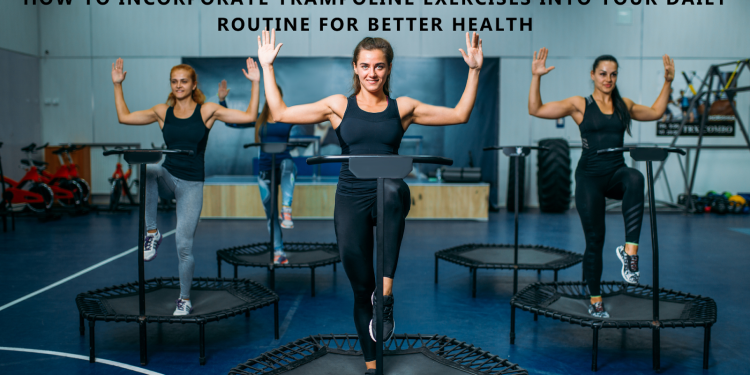Trampolines are not just for children anymore. Jumping, or “rebounding” on a trampoline has gotten popular with adults too. Incorporating trampoline workouts into your regular fitness routine offers a fun way to strengthen your heart, build your bones, joints, and core muscles, and burn energy efficiently.
Table of Contents
The Remarkable Benefits of Trampoline Exercises for Your Overall Health
Trampoline workouts give lots of health benefits beyond just fun. One study in a sports science magazine showed that just 10 minutes on a trampoline exercise pumps your heart more and burns more energy than 30 minutes of running! Because they are so efficient, trampoline workouts are great if you’re busy but want to get healthier.
Bouncing Your Way to Better Cardiovascular Health
Trampolines give a special boost to better heart health. According to the American Council on Exercise, people using a workout trampoline for adults in a trampoline fitness class had an average heart rate of 145 beats per minute. This means trampolines give your heart an intense workout! Changing direction while bouncing strengthens your heart muscle, improves blood flow, and makes your lungs work better.
Strengthening Bones, Joints, and Balance through Trampoline Workouts
Jumping on a trampoline is gentle on your bones and joints. Research from the International Osteoporosis Foundation says that high-impact exercise like rebounding can make bones denser. Working to stay balanced while bouncing also improves coordination. Trampolines help strengthen your bones, joints, and enhance body control.
An Efficient Calorie-Burning Exercise for Weight Loss
Want to get in shape and have a blast? Trampoline workouts burn lots of calories efficiently, so they’re excellent for slimming down. A NASA study learned rebounding burns 68% more calories than jogging! Alternating between fast and slow bounces during trampoline exercises increases your calorie burn.
Choosing the Right Trampoline for Your Needs
To start improving your health by bouncing, you’ll need the best rebounder trampoline for your needs. Here are key things to look at when picking one that fits your skill, space and budget:
Size: Standard trampolines range from 36 to 40 inches in diameter. Larger trampolines around 50 inches provide more room for exercise. Measure your space first.
Safety features: Prioritize safety with a trampoline that has padded spring covers, a durable jumping surface, and a safety enclosure net. Handlebars add stability.
Weight limit: Account for your weight and intensity of use. A higher weight limit around 250-300 lbs is ideal for adults.
Spring count: More springs mean a bouncier and more stable rebound. Go for a minimum of 30 springs.
Price: Quality trampolines for fitness cost $100 to $600. Focus on safety and durability over price alone.
Easy Trampoline Exercises for Beginners
Ready to start bouncing? Ease into trampoline exercise with these simple, low-impact moves recommended for beginners:
Jogging
- Mimic jogging on the ground while keeping light bounces.
- Start with 30-second intervals and increase duration as you build stamina.
Marching
- March in place, focusing on lifting your knees high with each bounce.
- Swing your arms naturally to maintain balance and engage your core.
Front & Side Leg Lifts
- Stand upright and lift one leg out in front of you, then switch.
- Repeat the movement lifting legs out to the side to target outer thighs.
Pike Jumps
- Start in a plank position with hands under shoulders, and legs straight behind you.
- Push off the trampoline, bringing your knees to your chest while in the air.
- Land back in plank, being careful not to lock your knees.
Arm Circles
- Bounce lightly while making controlled backward and forward circles with both arms.
- Keep your chest open and core engaged throughout the movement.
Start with 10-15 repetitions of each exercise, 1-2 sets, focusing on proper form. Increase difficulty by adding bouncing between moves.
Advanced Calorie-Burning Trampoline Workouts
Ready to turn up the intensity? Try these more challenging exercises that burn maximum calories:
Tuck Jumps
- Launch up from the trampoline, bringing knees to the chest while airborne.
- Land with soft knees, immediately bending into a squat before repeating.
Front Flips
- Start standing, jump up, and rotate your body forward mid-air into a front flip.
- Land on forefeet absorbs impact through knees and hips before repeating.
Suicide Sprints
- Start side-to-side, sprinting with high-bouncing knees for 30 seconds.
- Reverse and repeat, bouncing back to your starting point.
Seat Drops
- Start seated, engage your core, and drop through your heels onto your back with straight legs.
- Push back up with your hands to return to a seated position.
Single-Leg Bounces
- Lift one leg, balancing on the standing leg as you bounce for 30 seconds.
- Switch legs and repeat. Keep your core tight.
Build up to 3 sets of 30-60 seconds for each exercise, with breaks as needed. Listen to your body and don’t overdo it!
Safety First! Trampoline Exercise Guidelines
While trampoline exercise offers many benefits, take precautions to avoid injury:
- Learn proper form and posture for each exercise from a trainer if possible. Maintain a soft landing.
- Warm up muscles before bouncing with light cardio and stretches.
- Wear workout clothes and cross-trainers for support and traction. No socks/bare feet.
- Know your limits. Don’t overdo it to exhaustion or serious pain.
- Have a friend watch advanced flips and tricks to prevent accidents.
By using common sense, you can safely enjoy all the benefits of trampoline workouts!
Bouncing Into a Healthier Daily Routine
Integrating trampoline workouts just 2-3 days per week can improve your cardiovascular fitness, strengthen your bones and core, enhance balance and coordination, and help you manage your weight. Start slowly, focus on proper form, and increase difficulty over time.
With the astounding whole-body health benefits of trampoline exercise, you’ll be jumping for joy as you bounce your way to better health!
Frequently Asked Questions
- What safety precautions should I take when starting with trampoline exercises?
Pick trampolines with padding, handlebars, and nets. Learn techniques correctly, warm up first, wear workout shoes, don’t exhaust yourself, and use a spotter for intense stuff. Build up slowly over time.
- Can trampoline exercise be adapted for people with health conditions?
Yes, in moderation. Ask your doctor first, start with easy bouncing, and avoid advanced moves. For many conditions, trampolines gently help circulation and bones.
- How often should trampoline exercise be done for best results?
Aim for 20-30 minutes on a trampoline 2-3 days weekly. Going everyday risks hurting yourself. Listen to your body and take days off when needed. Just doing it once or twice a week consistently still helps.


 Home
Home










